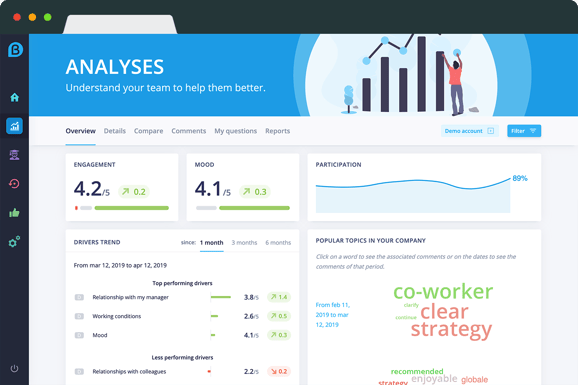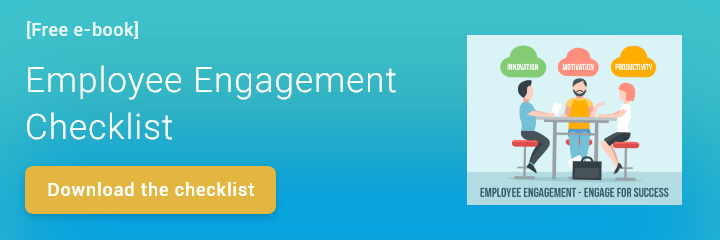“Satisfaction questionnaires”, “employee surveys”, “satisfaction surveys” and “employee satisfaction metrics” are all different names for ways of answering the same underlying question: how do we measure employee satisfaction?
We know for a fact that employee satisfaction is the key to the success of the best performing companies. Just take a look at these graphs published in the Harvard Business Review. Need we say more?

Here at Bleexo, we have a manifesto that guides our approach to both tech and management. Point 6 of this manifesto is: “People can push you forward or hold you back. The choice is yours!”
If, like us and all our clients, you have decided you want your people to “push you forward”, then measuring employee satisfaction is a must. After all, how can you improve something if you have no way of measuring it?
Let’s take a look at some possible solutions.
Measuring employee satisfaction
There are two main types of tools:
- Type 1: “inferred” or “symptom” indicators
- Type 2: premium solutions
These solutions are not necessarily particularly tricky to implement, but their approach and the type of data they provide are very different. Deciding which type of tool to use will impact directly on how much continuous HR improvement you can achieve.
“Inferred” solutions for measuring employee satisfaction
What these solutions share in common is the fact that the indicators are already at your disposal. They are “symptom” indicators that reflect levels of satisfaction within your teams. You can use these KPIs to infer changes, such as whether employee satisfaction is rising or falling. The problem is, you can’t explain them.
You will be well familiar with this type of indicator. It might be:
- Staff turnover: turnover rate = [(Number of resignations in a given year N + The number of new recruits in year N)/2] / Workforce at 1 January of year N.
- Staff absence = (Number of hours of staff absence during a given period / The theoretical number of working hours during that period) x 100.
- Referrals: you can infer levels of employee satisfaction from the proportion of new recruits who were referred by an existing employee.
- Service quality: it has been shown that employee satisfaction has a direct impact on the quality of customer service.
However, it is important to bear in mind that these indicators are just that. There are many examples where these indicators may be high and yet employee satisfaction is low. Take, for example, a restaurant where employees are required to behave in certain ways and those in charge have an old-school, harsh approach to management. This combination of tightly controlled behaviours and a harsh management style may mean that employees have to smile at the restaurant’s customers. The customer service would therefore be good, but would not reflect high levels of employee satisfaction.
In reality, such indicators are inherently biased.
Until something better comes along, you could use these indicators to create your own employee satisfaction “management cockpit”. By comparing them and looking for parallels, you should be able to strip out biases and identify useful pieces of information.
3: Step out of the dark and into the world of feedback!
Using dedicated indicators to measure employee satisfaction
Dedicated indicators are not inferred. To get them, you have to seek data at source. You can do this using surveys with different levels of detail, that have been designed to a greater or lesser degree for HR purposes.
We can distinguish between:
- Measurement indicators (e.g. “Would you recommend that a friend comes to work here?”)
- Explanation indicators (e.g. “Why would you recommend that a friend comes to work here?”) These indicators many focus on a set of highly specific and interdependent dimensions that help you understand the how and the why. Here at Bleexo, we carry out real-time analysis of no fewer than 40 dimensions as a minimum. These may relate to areas such as the subject matter of employees’ work, their relationships with colleagues and managers, whether their work is meaningful, how their company is structured, their workload, recognition and company values.
How to manage employee satisfaction surveys ?
Generic survey platforms
This type of platform allows you to create surveys online. The best-known example is Google Forms. While they are free and very easy to use, the extent to which they can measure employee satisfaction is limited, for example, in terms of processing and exporting data, sharing results and setting up recurring surveys.
Dedicated employee survey platforms
Clearly, we think Bleexo is the best!
With this type of platform, you can set surveys to recur, as well as easily segment, sort, compare and slice up data. You also have access to banks of themed questions. When you look at the ways you are able to make use of the data and how easy the platform is to use, the difference couldn’t be more obvious.

Choosing a dedicated employee satisfaction platform: 20 key criteria
When it comes to choosing software, be sure to consider these 20 criteria carefully. The devil is in the detail; these factors will impact on how easy the software is to use, whether it is adopted by your teams and the opportunities it offers your company to progress.
- Data security
- Survey frequency
- UX (user experience)
- Support and guidance
- Targeting
- Question bank
- Power of the survey algorithm
- Flexibility (e.g. recurrent vs. one-off surveys)
- Access permissions
- Bottom-up conversations
- Graph/chart options
- Data analytics: sorting and analysis options
- Languages
- Semantic analysis
- Download vs. SaaS
- Calculation speed
- Price
- Integration with existing HRIS
- Complementary tools
- Improvements and innovations




